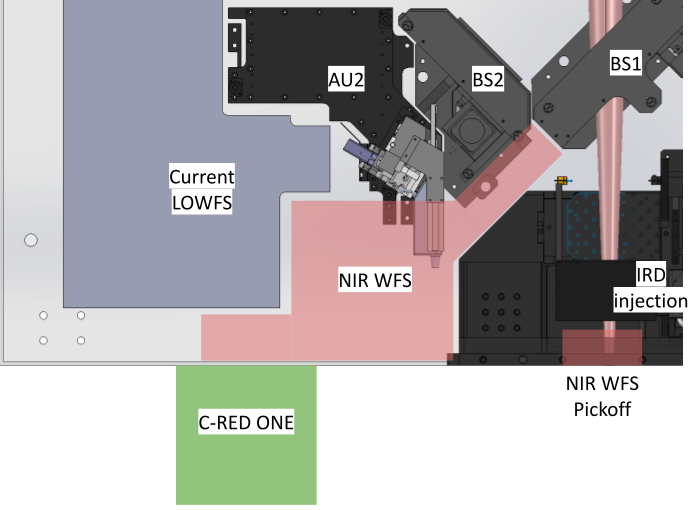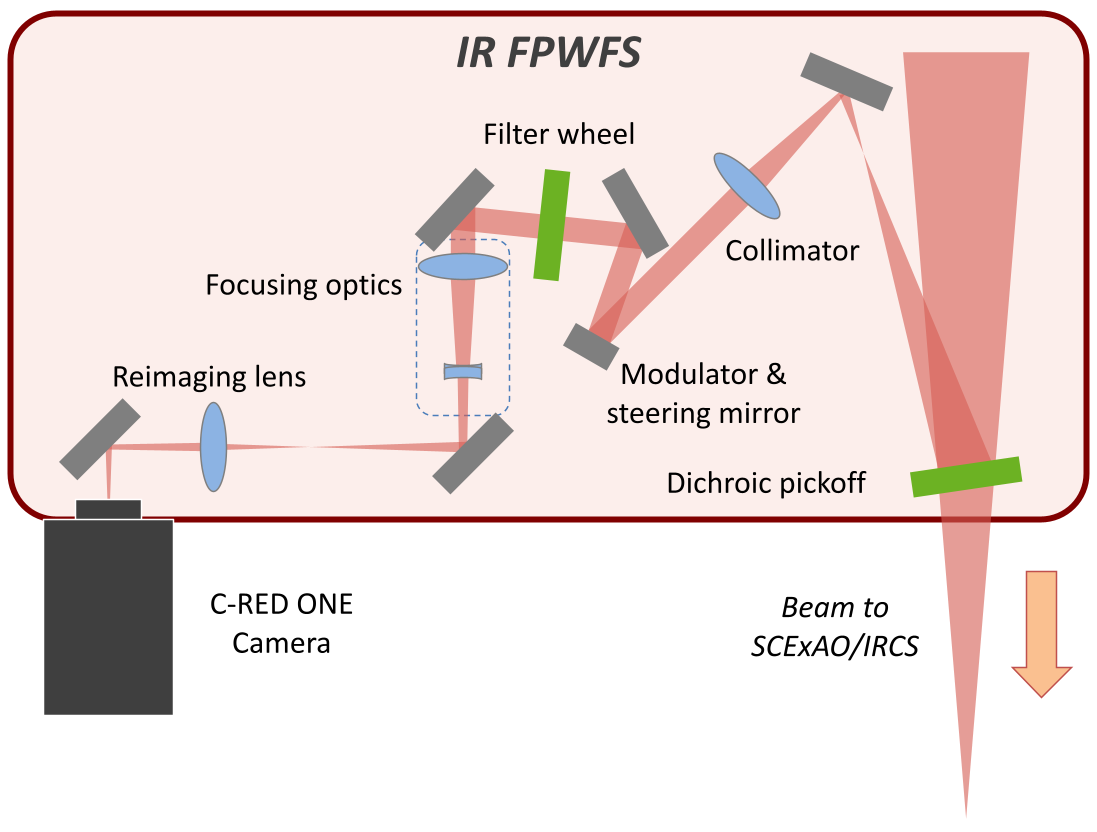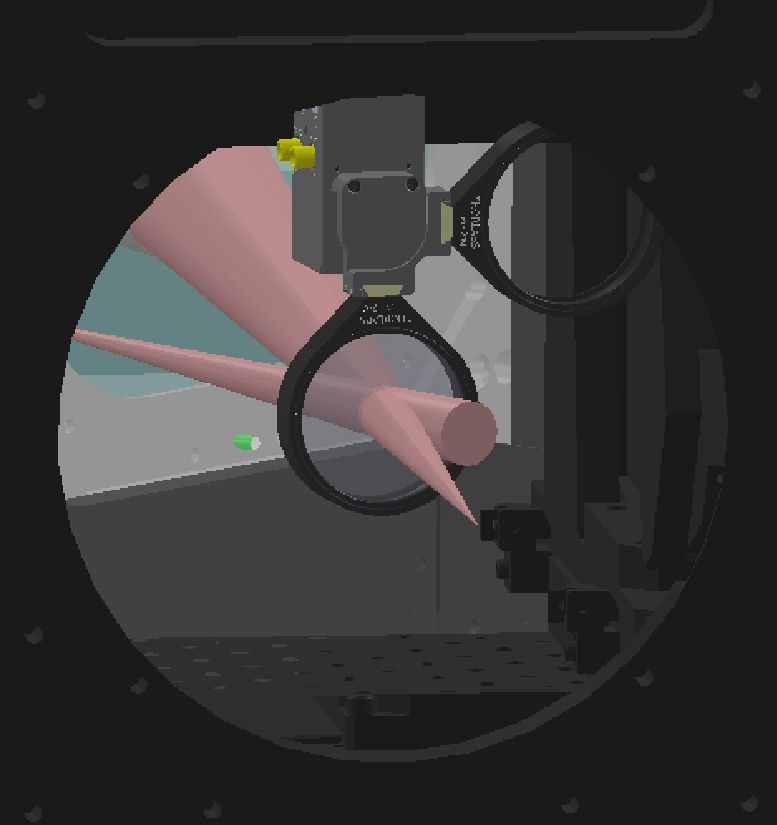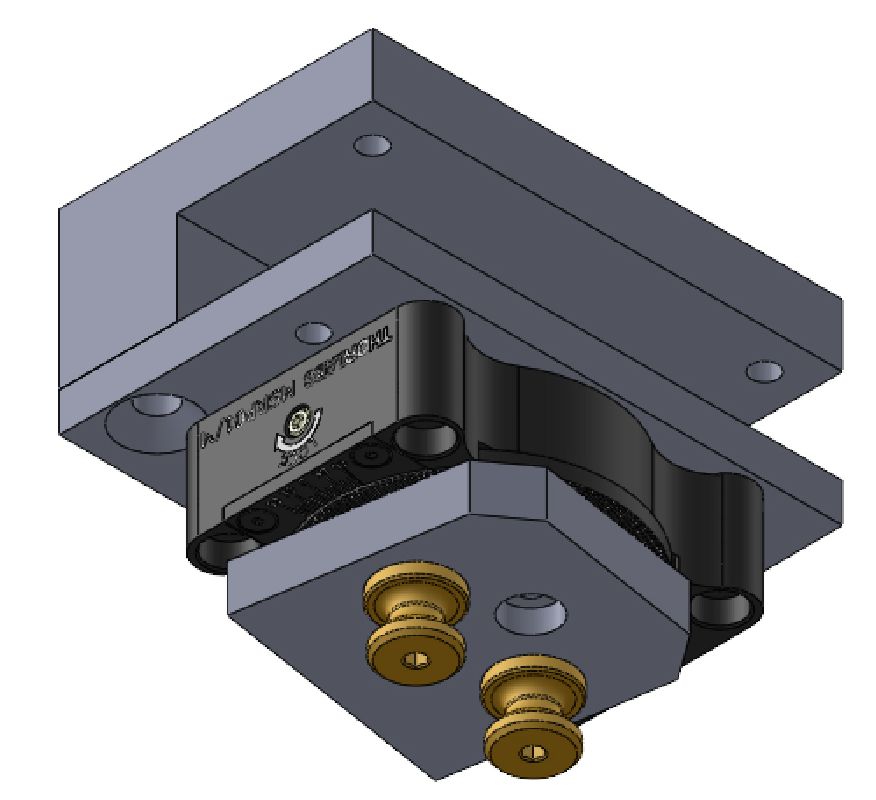Near-IR Wavefront Sensor - Technical Description
Position inside AO188
Optical path
The NIR WFS is designed to have two modes:- Pyramid Wavefront Sensing (PyWFS) mode
- Focal Plane WFS mode (FPWFS)
Pyramid Wavefront Sensing (PyWFS) mode
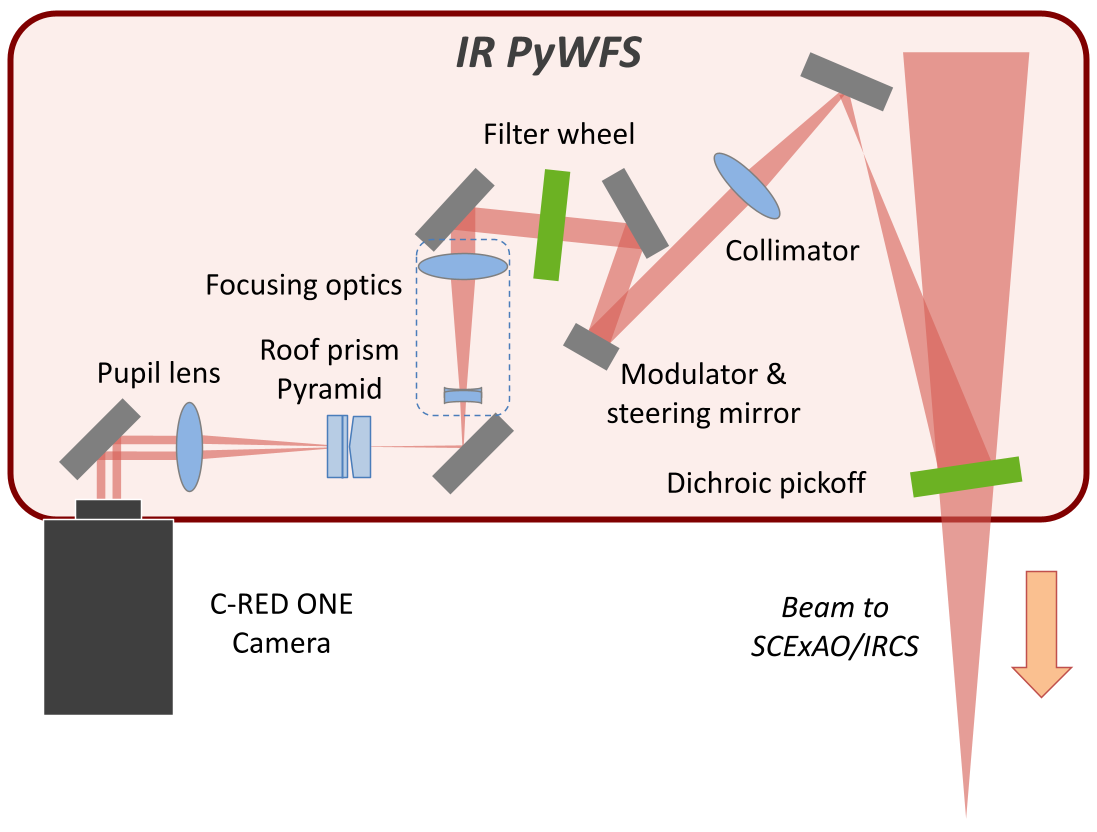 |
A pair of roof prisms splits the beam in 4. This concept was validated with the visible PyWFS of SCExAO. |
|---|
Focal Plane WFS mode (FPWFS)
NIR WFS dichroic beamsplitter
Several beamsplitters are available, depending on the instrument and science case. Since the flip mount only accommodates one optic at a time, a choice has to be made before each observing run on what beamsplitter to use. Once the Nasmyth Beam Switcher is installed, version 2 of the NIR WFS will move to the LTAO WFS platform, and we will have enough space to include a mechanism (wheel or linear actuator) to switch between the different options.
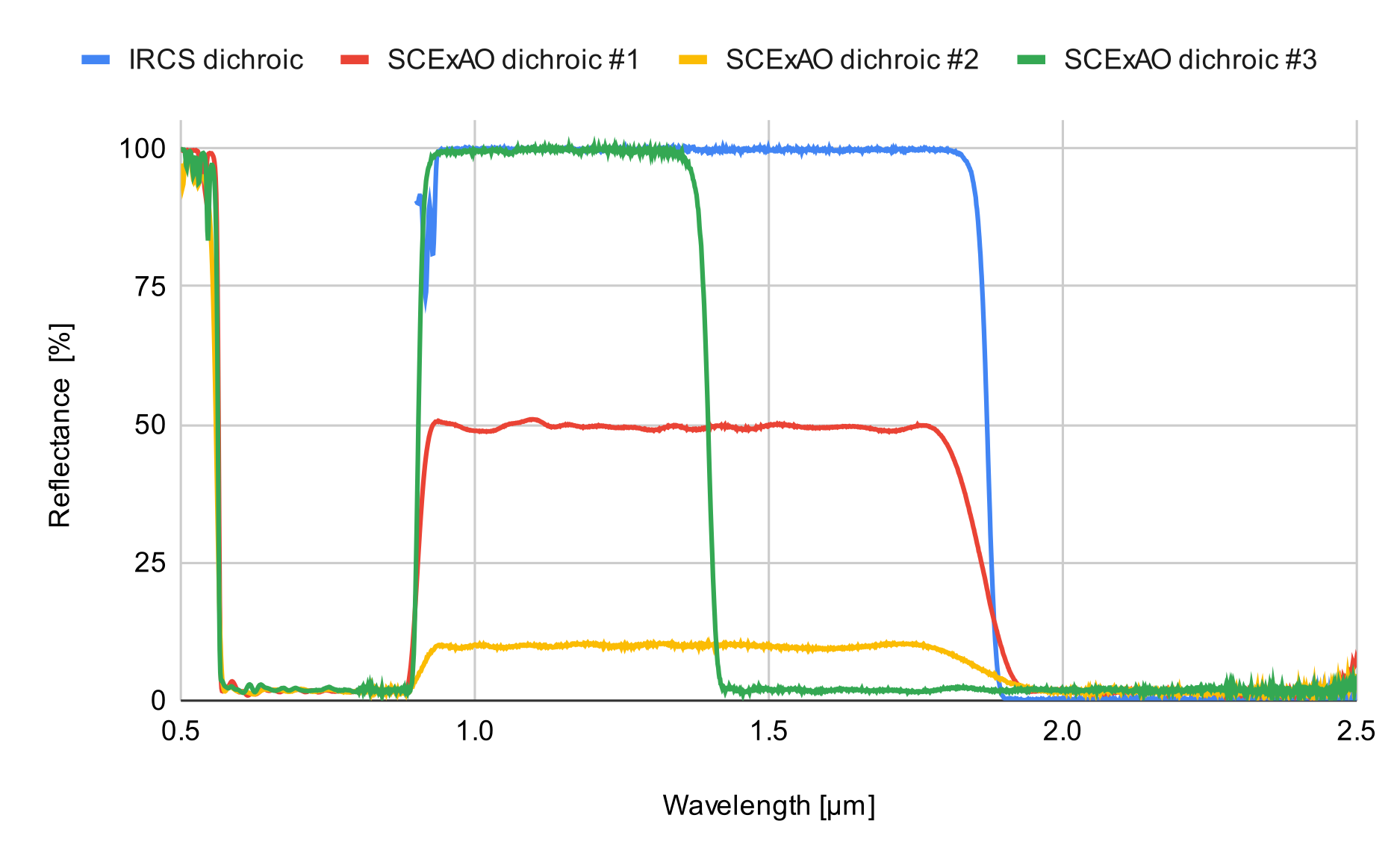
- A dichroic BS for IRCS, sending 100% of y, J and H band to the NIR WFS, 100 % of K-band to IRCS.
- A first dichroic BS for SCExAO, sending 50% of y, J and H-band to the NIR WFS, 50 % to SCExAO, in addition to 100% of visible light (600-900 nm) and K-band.
- A second dichroic BS for SCExAO with the same characteristics as the first one, but sending 10% of y, J and H-band to the NIR WFS, 90% to SCExAO (for brighter targets).
- A third dichroic BS for SCExAO, sending 100% of y and J band to the NIR WFS, 100% of the visible and H and K-band to SCExAO.
Core optics
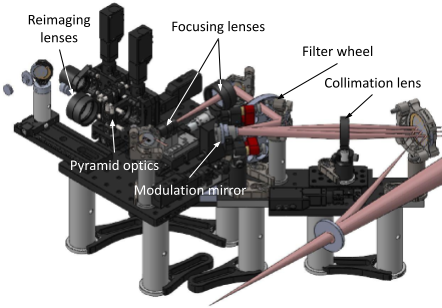 |
The core optics were designed to fit in the small space available inside AO188. Two platforms installed on 1.5” columns reduce the beam height from 250 mm to 106 mm |
|---|
The narrow platform contains:
- A first 2-inch fold mirror.
- A 150 mm collimation lens. The lens is on a motorized translation stage to change the focus.
- A ½-inch modulation mirror where the pupil is reimaged. The modulation mirror is on a motorized tip/tilt mount, to use off-axis stars as guide stars.
- A second 1-inch fold mirror. The large platform contains the rest of the optics.
The large platform contains the rest of the optics :
- A filter wheel that can reduce the bandwidth of the WFS. It contains 3 band filters (y, K or H-band), 2 dual-band filters (y+J and J+H) and an open slot.
- A third 1-inch fold mirror.
- A converging+diverging lens combination allows one to focus on the pyramid optics with the right F/ratio while keeping a compact configuration. The diverging lens is on a motorized mount to change the distance between the lenses (therefore the F/ratio), while the combination is on a motorized translation stage to focus precisely on the tip of the pyramid optics.
- A fourth 1-inch fold mirror.
- The dual roof prism pyramid optics splitting the light for the wavefront sensor. The optics are on a motorized vertical translation stage, which allows to move it out of the way for a focal plane imaging mode.
- Two lenses on a motorized X/Ystage: one 80 mm lens reimaging the 4 pupils on the detector for the PyWFS mode, and one 150 mm lens reimaging the focal plane for the FPWFS mode.
- A fifth 1-inch fold mirror.
Camera
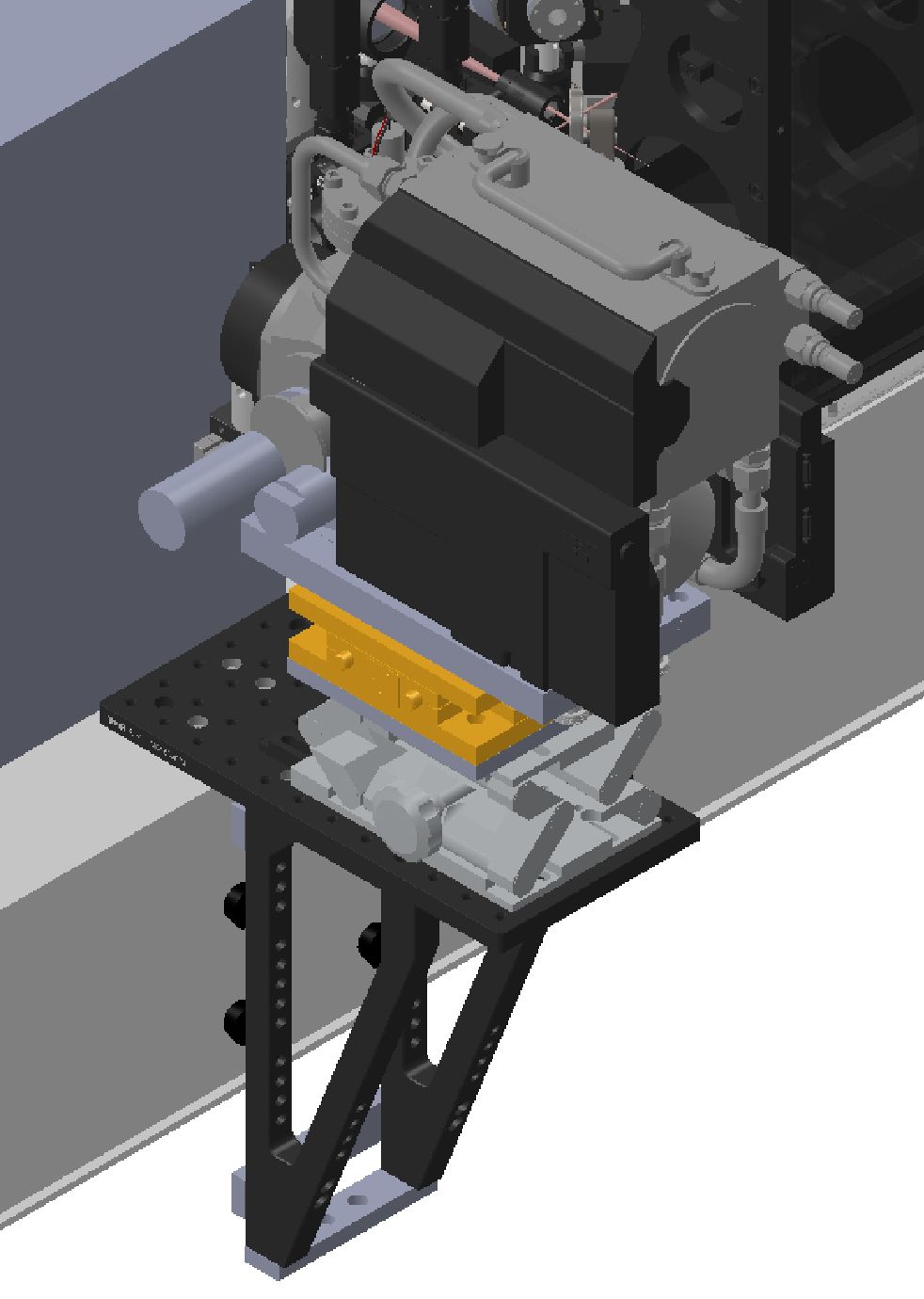 |
C-RED ONE camera mount design for the NIR WFS. The alignment mount between the platform and the camera is a duplicate of the FPDI mount. Camera Mounting |
|---|
The camera is mounted on a platform hanging on the side of AO188, supported by brackets resting against the side of the AO188 bench. This was the only possible solution due to the optical path, the lack of space inside AO188, and the constraint on the shared use of the camera with SCExAO FPDI mode (although this constraint will not exist once the Nasmyth Beam Switcher is installed). For alignments, the camera is mounted on a high-load lab jack for vertical alignment, as well as a high-load 2-axis stage, for horizontal and focus alignment. This is a duplication of the alignment mount of the FPDI, which performs very well.
Camera Settings
The default window size is 160x160 pixels, although the full frame (320x256 pixels) could be used for the FPWFS mode. With a 160x160 pixel window, the acquisition runs at a maximum frame rate of 9.8 kHz. We can then use the camera in correlated double sampling (CDS) mode or non-destructive read (NDR) mode to get the optimal noise level and speed, between 1 and 4.9 kHz depending on the target brightness. CDS is the default mode, since the camera integrates during a whole cycle of the modulator. If the modulation is not used, then NDR could be used. The detector gain can also be adjusted between 1 and 121 (max) for bright targets.
The C-RED ONE camera is used in Correlated Double Sampling (CDS) mode, where the sub-frame is read immediately after a frame reset, then reset and read again. The result is the difference between the frame before the reset and the previous one just after the reset. The sub-frame used is 160x160 pixels, with a read time of tread = 102 μs. So if we program the CDS mode to run at a frequency FCDS, then the actual integration time tint will be:
tint=1FCDS-tread.
In that case, we do not want the modulator to be synchronized with the CDS reads, otherwise we would lose a fraction
of the rotation during the actual integration time. Therefore, the modulation frequency Fmod is set to
Fmod=1tint=FCDS1-FCDStread.
Integration time, modulator frequency and maximum modulation radius for various loop frequencies
The Table below presents the integration time, modulator frequency and maximum modulation radius for various loop frequencies. The maximum frequency for CDS mode and the desired sub-window is 4.9 kHz, at which point the duty cycle drops to 50%. The readout scheme creates a rolling shutter effect linked to the duty cycle that is out of the scope of this paper, although we will probably always be at or below 2 kHz, where this effect will not impact us too much.| Integration time, modulator frequency and maximum modulation radius for various loop frequencies | |||||
|---|---|---|---|---|---|
| CDS frequency [Hz] | 500 | 750 | 1000 | 1500 | 2000 |
| Actual integration time [ms] | 1.898 | 1.231 | 0.898 | 0.565 | 0.398 |
| Modulator frequency [Hz] | 526.9 | 812.1 | 1113.6 | 1771.0 | 2512.6 |
| Maximum modulation radius [mas] | 250 | 190 | 145 | 60 | 40 |
File ./020instrument.web/030nearIRwfs.web/010technicaldescr.web/content.html last modified 26/07/2023 19:19:39 HST

